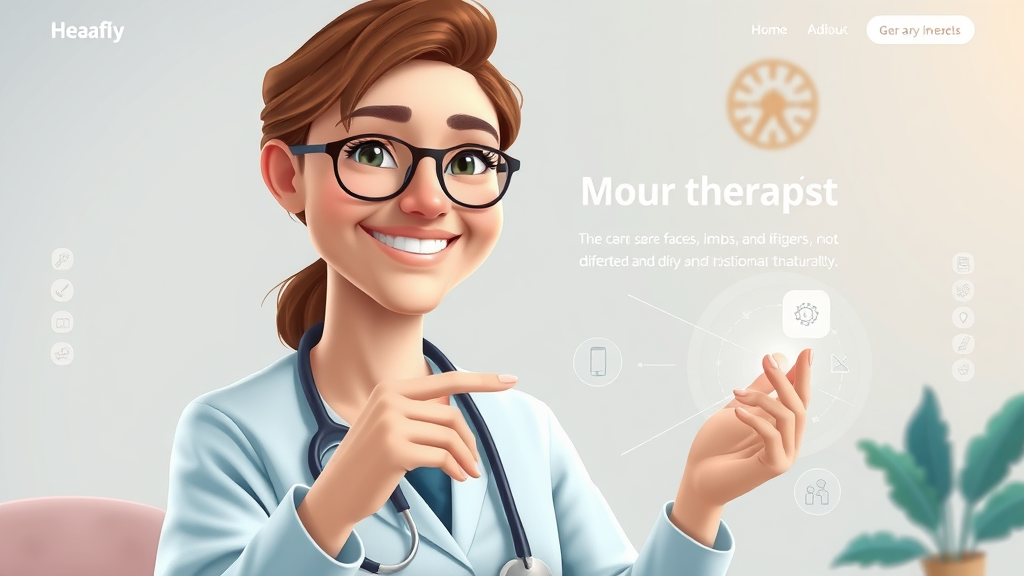Did you know that over 70% of therapy practices saw a dramatic shift in client acquisition behaviors post-pandemic, with digital channels overtaking traditional word-of-mouth referrals? The landscape for therapist client acquisition 2025 is more competitive and digitally driven than ever before. If you’re a therapy practice owner—or just getting started—this comprehensive guide will give you the most effective, up-to-date strategies to significantly boost your client base , attract ideal potential clients, and future-proof your marketing efforts. Stay tuned to learn expert techniques that top private and group practice owners are using to thrive in today’s digital landscape.
Why Therapist Client Acquisition 2025 Requires a New Approach
Did you know that over 70% of therapy practices saw a dramatic shift in client acquisition behaviors post-pandemic, with digital channels overtaking traditional word-of-mouth referrals?
- Major digital transformation in therapy practices
- Surge in online presence and telehealth adoption
- Increasing competition and the need for niche marketing

The therapist client acquisition 2025 environment is vastly different than just a few years ago. Traditional referral sources are no longer a primary funnel for potential clients; instead, most inquiries now begin online. This transformation requires practices to rethink their marketing strategies and invest in a robust, strong online presence . Embracing telehealth, digital tools, and innovative client engagement methods isn't optional—it's essential for growth.
Furthermore, as therapy becomes more accessible and visible, private practice owners and group practices face a surge of competition locally and nationally. Standing out demands niche marketing, authentic branding, and leveraging the platforms where potential clients spend their time. The emergence of digital-first practices, equipped with up-to-date digital marketing expertise, demonstrates how important it is to adopt a new approach to client acquisition in 2025.
Key facts support these trends: a widespread shift to telehealth, the necessity of a professional digital image, and the increasing importance of reputation management all now play pivotal roles. To thrive, therapists must develop strategies that cater to online behaviors and digital expectations—because this is where clients will find, research, and choose their mental health support.
Understanding the Psychology of the Modern Potential Client
- How client expectations are changing
- The role of convenience and accessibility in private practice
- Building trust in group practice and solo therapy practice settings
Today’s potential clients are savvier, better informed, and expect therapeutic services to align with their tech-driven lifestyles. Immediate online scheduling, transparent service lists, and clear practitioner profiles are now essentials. Convenience isn’t just appreciated; it’s demanded, especially in private practice where clients seek therapy that fits seamlessly into busy schedules. Accessibility—through telehealth, mobile responsiveness, and prompt communication—is shaping how potential clients select their providers.
Building trust—whether in group practice or a solo therapy context—requires therapists to show transparency, competence, and compassion across their entire online presence . This means publishing detailed bios, credentials, and testimonials; offering content that speaks to unique client concerns; and maintaining open channels for communication. When practices intentionally focus on these psychological expectations, their inquiry and conversion rates rise dramatically.
The therapist client acquisition 2025 journey now starts with digital research. Potential clients often visit multiple therapy practice websites, check for reviews, consume mental health content on social media , and assess trustworthiness before reaching out. Tailoring marketing strategies and communications to address these new concerns is critical for private practice success in the coming years.
Essential Digital Marketing Strategies for Therapist Client Acquisition 2025
For therapy practices aiming to thrive, digital marketing is at the core of effective therapist client acquisition 2025 . With an increased reliance on online searches, it’s vital to have a marketing plan that reflects current behaviors and technology trends. This section breaks down the building blocks of modern digital marketing including web optimization, local SEO, Google Business, and service showcasing, all tailored to convert potential clients into actual appointments.
The essential strategies involve multiple elements: enhancing your search engine visibility so your practice surfaces atop the search results, crafting a business profile that’s both informative and persuasive, and showcasing your range of therapy services in ways that address the diverse needs of your client base. Let’s dive into how each of these can empower your practice to reach and attract more clients in 2025.
Adopting these digital marketing essentials not only increases exposure but builds trust and authority, ensuring that both group practice and solo therapists maintain relevance in a rapidly changing mental health landscape. Practical examples include SEO-rich blog content, intuitive web navigation, and robust listings on online directories, all working together to attract and retain the ideal client.
Optimizing Your Therapy Practice for a Strong Online Presence
A strong online presence is now non-negotiable for therapist client acquisition in 2025.
- Website essentials: SEO, user experience, compelling copy
- Crafting a business profile that converts potential clients
- Showcasing therapy services for different client types

Building a strong online presence is more critical than ever. This starts with a modern, mobile-responsive website designed specifically for your private or group practice. Your site should highlight your therapy services clearly, include easy-to-use navigation, and feature clear calls-to-action (CTAs) guiding potential clients to initiate contact or schedule an initial consultation . Consistent SEO ensures your practice appears in relevant search results, increasing discoverability for those seeking mental health support nearby.
An effective business profile introduces your credentials, areas of specialization, and empathetic approach concisely. Use authentic photography, detailed service descriptions, and persuasive client testimonials to build trust. Showcasing varied therapy services—for individuals, families, or specific mental health issues—signals you understand and meet diverse client needs. Compelling, story-based website copy can make your practice memorable in a crowded market, while leveraging video or “our approach” pages further enhances client connection.
In 2025, it’s not just about having an online presence but about having a strong online presence that instills confidence and provides a seamless experience for potential clients. Ensuring your site loads quickly, looks great on any device, and reflects your brand values will set your practice apart and drive more inquiries.
Leveraging Local SEO and Google Business for Private Practice Growth
- Why local SEO matters for therapist client acquisition
- Google Business profile optimization
- Attracting potential clients searching for therapy services near them
If you want to attract therapy clients in your city or region, local SEO is a must. When potential clients type “therapy near me” or “mental health counseling city_name,” your Google Business profile and optimized website should appear at the top of the search results. Google’s algorithm now prioritizes complete, accurate business profiles—so include your latest contact info, professional photos, detailed service listings, and client reviews.
Optimization steps include claiming your Google Business profile, using keywords relevant to your therapy practice, and frequently updating your content and images. Encourage satisfied clients to leave reviews—it not only boosts your visibility but also builds trust for potential clients deciding between you and your competitors. Embedding a Google Map and listing your location further signals authority for local search intent.
A robust local SEO strategy incorporates backlinks from reputable local directories and cross-promotion with allied health professionals, which strengthens your digital footprint. For private practice owners, this means greater authority online, increased inquiries from nearby clients, and a tangible edge over less tech-savvy competitors.
Social Media: Unlocking New Channels for Therapist Client Acquisition 2025

Social media is one of the fastest-evolving frontiers for therapist client acquisition 2025 . With platforms like Instagram, Facebook, and LinkedIn, therapists have unprecedented reach to share mental health education, showcase success stories, and build genuine relationships—even before an initial consultation takes place. Strategic use of social media can make the difference between a stagnant practice and exponential growth.
Whether your practice serves local communities or a broader, telehealth client base, mastering social media helps you connect authentically, demonstrate your expertise, and foster engagement. Private practice owners are increasingly adopting video content and interactive posts to stand out in news feeds while also leveraging paid promotions to reach new audiences quickly.
To maximize your impact, align your messaging with audience needs—offer practical tips, share relatable encouragement, and address trending mental health topics. Remember, it’s not just about broadcasting services but building trust through conversation, transparency, and visible support for your community.
Choosing the Right Platforms to Expand Your Client Base
- Comparing Instagram, Facebook, and LinkedIn for therapy practice
- Building community and demonstrating expertise for mental health support
- Do's and don'ts of paid advertising on social media
Each social media platform offers unique strengths for therapy practice marketing. Instagram is ideal for visual storytelling, offering behind-the-scenes looks into your therapy services and sharing educational graphics to boost brand awareness. Facebook excels at local engagement through groups and events, making it an effective choice for private practice owners looking to build community or retarget interested clients. LinkedIn, meanwhile, is a hub for professional credibility—perfect for networking with other health professionals and connecting with B2B opportunities, such as EAP contracts or speaking events.
To maximize your client base , choose 1–2 platforms that match your target demographic and dedicate time to consistent posting and authentic interaction. Paid advertising on these channels can deliver quick results if approached strategically: always target based on location and interests, use clear CTAs, and split-test ads for optimal performance. Avoid salesy language or sharing confidential information; focus on education, empathy, and visibility instead.
For private practice and group practices alike, the core strategy is to establish a consistent, helpful presence—answering common questions, spotlighting services, and inviting followers to schedule consultations. This approach lays the foundation for a strong online presence and a referral-generating community around your brand.
Content Marketing and Authentic Engagement for Therapy Practices
- Topic ideas that attract potential clients
- Using video, stories, and live content to build trust
- Engagement metrics that matter in 2025

Content marketing is the art of providing valuable, relevant information to earn potential clients’ trust—and ultimately their business. Blogs, articles, podcasts, and short videos help you reach new audiences searching for mental health support and therapy services . Topic ideas for your content calendar might include anxiety coping skills, the benefits of therapy, and myth-busting posts about common mental health concerns.
Authentic engagement is built through video, stories, and live sessions. These formats foster a direct connection, allowing potential clients to see your personality, approach, and expertise upfront—critical for client acquisition in a crowded market. Live Q&As, personal insights, and “day in the life” content consistently outperform static posts in terms of reach and trust-building metrics.
When evaluating your efforts, key metrics to track in 2025 include post saves and shares (indicating content resonance), direct messages and comments (measuring engagement), and appointment requests or consultation bookings (validating ROI). By fostering real conversations and meeting clients where they are, your practice creates a foundation for long-term relationships and referrals.
| Channel | Strengths | Weaknesses | Best Used For |
|---|---|---|---|
| Visual storytelling, reach | Requires consistency | Brand awareness, education | |
| Targeted local reach, groups | Organic reach declining | Community building, retargeting | |
| Professional credibility | Lower engagement | Networking, B2B connections | |
| Google Ads | High intent, fast results | Can be costly | Lead generation, new services |
Paid Advertising and Google Ads for Therapist Client Acquisition 2025
Paid advertising is a powerful lever for fast-tracking growth, especially when organic competition is fierce. With platforms like Google Ads and tailored social media ads, therapists can target their ideal client base based on intent, interests, and local geography. In 2025, integrating paid campaigns adds predictability to your new client pipeline, helping you scale appointment bookings and minimize downtime.
It’s critical to approach paid advertising methodically: start with clear goals (brand awareness, lead generation, or specific service promotion), use data to inform your targeting, and invest in ongoing optimization to ensure a positive ROI. By applying proven advertising strategies, both private and group practices can turn digital exposure directly into high-quality inquiry flow.
The flexibility of paid channels makes them ideal for launching new therapy services , promoting workshops, or filling unexpected gaps in your schedule. When done strategically, paid ads can complement organic marketing and create a sustainable blend for long-term client acquisition .
Creating Effective Google Ads Campaigns for Therapy Practice
- Identifying best keywords for mental health services
- Setting up conversion tracking
- Budgeting and measuring ROI

To maximize gains with Google Ads , begin by researching keywords your potential clients actually use: “therapy near me,” “anxiety counseling,” or “online couples therapy.” Next, create clear, compelling ads that reflect your core offerings—using ad extensions for scheduling links and showcasing trust signals like testimonials.
Conversion tracking is a must. Set up Google Analytics to measure which ads drive calls, online forms, or booked sessions. This clarity enables you to shift your budget toward top-performing campaigns and deactivate ads that underperform. When you review results, calculate true ROI—not just cost-per-click, but the actual value each new client brings to your therapy practice.
Effective Google Ads campaigns don’t just increase clicks—they lead to more client inquiries and a full schedule. Even a modest budget, if properly managed, can be enough to keep a private practice consistently growing, even in highly competitive mental health markets.
Exploring Paid Advertising Beyond Google Ads
- Social media paid advertising strategies
- Evaluating costs between Google Ads and social media
- Successful examples from private and group practice
"Many private practices doubled their monthly client intake with highly specific ad campaigns tailored to niche services in 2024."
While Google Ads delivers high-intent leads, social media paid advertising campaigns excel at building awareness and nurturing relationships with potential clients who aren’t actively searching—yet. Platforms like Facebook and Instagram offer hyper-targeted ad options (by age, interests, and location) and sophisticated retargeting features to bring curious visitors back to your site.
Cost-wise, social media ads can be more affordable than Google Ads for initial engagement, but often require sustained effort and content variety to move leads down the funnel. Successful case studies show that combining both—Google Ads for high-intent, ready-to-book clients, with social media for brand nurturing and community building—is a winning approach for private practices, group practice, and even niche therapy services.
The key is testing: experiment with small budgets, track which channels convert best, and iterate. By combining several paid advertising strategies, therapists ensure a diversified client acquisition plan for 2025, minimizing the risk from relying on a single channel.
Developing a Strong Online Presence for Sustainable Private Practice Growth

Think of your strong online presence as the foundation of sustainable client growth in 2025. It’s about more than just visibility—it’s about recognition, trust, and engagement that persists over time. By investing in distinct branding and a professional website, you attract not just more clients, but the ideal potential clients for your unique practice.
The path to growth involves unifying your brand messaging, consistently presenting your value, and making it effortless for potential clients to find, research, and contact you online. When you combine branding with a search engine-optimized website and active community engagement, your therapy or group practice becomes a go-to choice, even in a crowded marketplace.
Your digital identity should reflect the values and specialties you offer, making every touchpoint—from your logo to your blog—reinforce why clients should choose your practice. In turn, a polished strong online presence future-proofs your marketing and builds a resilient therapy business.
Branding for Therapists: Stand Out in a Crowded Market
- Differentiating your therapy services
- Defining your ideal potential client profile
- Aligning messaging across all channels
In a world where clients have endless choices, branding is your secret weapon. Start by identifying what makes your therapy services uniquely valuable: Are you specialized in trauma? Do you focus on families, teens, or couples? Is your mission rooted in culturally responsive care? These distinctions must appear throughout your website, business profile , and social media.
Next, build an ideal client profile —a detailed description of the people you serve best. Use this profile to customize messaging, select marketing channels, and even determine which community partnerships to pursue. When every post, ad, and page speaks directly to your ideal client’s needs, conversion rates soar.
Synchronize your messaging and visuals across all digital platforms. Consistency increases recognition and reinforces your credibility. Whether a potential client discovers your group practice on Facebook, in a blog post, or via a Google search, the experience should be seamless and unmistakably yours.
Professional Website Design and Search Engine Visibility
- Mobile responsiveness and accessibility
- Integrating blog content for search engine optimization
- Utilizing testimonials to build trust

The best therapy websites in 2025 are visually appealing and highly functional. Mobile responsiveness is essential, as most clients discover services from their smartphones. Web accessibility ensures everyone, regardless of ability, can find and use your site. Integrating a regularly updated blog—optimized for high-intent keywords—strengthens your visibility in search engine results and demonstrates ongoing expertise.
Showcasing client testimonials (with proper consent) establishes social proof and increases trust. Video or written feedback about positive experiences underscores your effectiveness and empathy, persuading new potential clients that you’re the right choice.
Finally, ensure that contact forms, scheduling tools, and location details are easy to access on every page—reducing friction and encouraging bookings. A professional, optimized website will do far more than look good: it will become your #1 sales tool for therapist client acquisition 2025 .
Building and Nurturing Your Email List for Therapist Client Acquisition 2025
- Why email marketing builds lasting client relationships
- Creating opt-in offers for potential clients
- Best scheduling and follow-up practices

"An engaged email list remains the most valuable asset for client retention and growth in 2025."
While social media and ads drive many first points of contact, an email list remains your most durable direct line to both current and potential clients. Building your list starts with irresistible opt-in offers—such as downloadable wellness guides, video lessons, or mini assessments—delivered in exchange for an email address on your website.
Nurturing your email list pays off: regular, value-rich newsletters keep your brand top-of-mind, enable personalized outreach, and increase client retention . Powerful follow-up practices include automated scheduling reminders, check-ins after sessions, and mental health tips that reinforce your expertise.
Unlike public digital platforms, your email list is an owned asset that’s immune to algorithm changes or paid promotions. It is the foundation for workshop invitations, satisfaction surveys, and even referral campaigns, making it a must-have for private practice resilience in 2025.
Client Retention: Maintaining a Thriving Therapy Practice in 2025
Acquiring new clients is only half the battle—retaining them is where the true value lies for long-term private practice growth. Client retention ensures your therapy practice remains profitable, your schedule stays full, and satisfied clients become loyal referrers. In 2025, innovative retention tactics are as vital as acquisition strategies.
This section explores how to foster satisfaction, set up continuous feedback loops, and build a community that keeps clients engaged and coming back for ongoing mental health support. Happy clients mean positive reviews, more word-of-mouth, and less reliance on expensive external marketing.
To keep your practice thriving in a digital world, make every client interaction meaningful, support their long-term wellness journey, and stay open to feedback that helps refine your services.
Techniques for Increasing Client Retention and Satisfaction
- Continuing education for therapists
- Building a feedback loop with clients
- Personalization and follow-up in therapy services

Upgrade your skills with ongoing education to bring the latest modalities and innovations into each client session. This dedication to professional growth is deeply valued by today’s mental health seekers, increasing trust and satisfaction. Encourage honest feedback through post-session surveys or follow-up emails; this not only improves your services but gives clients a voice in their own therapeutic journey.
Personalization is a major retention driver—remember key milestones, tailor follow-ups based on session progress, and suggest relevant resources or check-ins between appointments. Automated but genuine communication (like birthday notes or relapse reminders) builds loyalty and deepens the client-therapist bond.
These techniques are not only effective in private practice but also scalable across group practice settings, allowing every client to feel recognized, valued, and motivated to stay engaged for the long term.
Cultivating Community and Referrals for Ongoing Growth
- Running workshops and support groups
- Networking with other mental health professionals
- Local SEO strategies for ongoing referral opportunities
Expand your reach by offering specialized workshops or support groups—either virtual or in-person. These lower-barrier events are powerful for introducing new potential clients to your services, showcasing expertise, and building a supportive community around your therapy practice.
Strong networking with local health professionals and complementary service providers (such as physicians or wellness coaches) fuels steady referral streams. Don’t underestimate local SEO : regularly update your Google Business profile and encourage happy clients and partners to leave reviews, boosting visibility and referral opportunities within your local area.
Creating a sense of community—through both digital channels and in real-world settings—drives enduring growth for private and group practices, making client acquisition a natural by-product of your ongoing professional relationships.
Marketing Strategies for Group Practice and Private Practice in 2025
The most effective marketing strategies are tailored to your practice model. Whether you operate a rapidly expanding group practice or a focused solo business, the path to growth in 2025 demands agility, targeted outreach, and leveraging your practice’s unique strengths.
Group practices must manage multiple practitioner profiles and balance digital branding for both the collective and each individual provider. Solo and small practices, meanwhile, need to maximize time and marketing budgets with highly targeted community partnerships and efficient outreach.
This section provides actionable approaches for both practice types, helping owners to adapt, compete, and prosper using digital-first client acquisition strategies.
Tailored Approaches for Group Practice Expansion
- Managing multiple practitioner profiles online
- Balancing in-person and telehealth sessions
- Leveraging group dynamics for marketing
Group practices should showcase each provider’s profile, specialty, and availability on their master website and across key digital directories. This not only meets diverse client needs but also boosts search engine visibility for a broader set of keywords (e.g., “child therapy in city_name”).
Offering both in-person and telehealth options broadens your reach, catering to different client preferences and expanding your service area beyond traditional borders. Highlight these flexible service offerings consistently throughout your social media, ads, and business profile platforms.
Leverage the team dynamic by publishing group-authored articles, joint live Q&A events, or collaborative mental health campaigns. This communicates authority, attracts media attention, and draws in clients interested in comprehensive care options available only in group practice settings.
Best Practices for Solo and Small Private Practices
- Time management for solopreneurs
- Affordable marketing strategies for private practice
- Creating targeted community partnerships
Time is a premium for solopreneurs, so automated marketing tools and a limited but consistent digital presence are key. Schedule content in batches, use template-based emails, and limit your focus to 1–2 core channels (such as Google Business and a single social media account) that drive the highest ROI.
There are plenty of affordable strategies that deliver results: partnering with local wellness businesses for cross-promotion, speaking at library or school events, and guest blogging on regional mental health sites can all bring new potential clients to your private practice. Consider “office hours” on social media as a no-cost way to answer questions and engage your audience.
Above all, build relationships with organizations, support groups, and referral partners who serve your ideal client profile. By anchoring outreach in genuine service rather than self-promotion, small practices see outsized returns on their marketing efforts.
People Also Ask
How do therapists get more clients in 2025?
- Combining digital marketing, local SEO, a strong online presence, and consistent client retention practices ensures steady client acquisition for therapy practices.
What is the best digital marketing strategy for therapy practice growth?
- Integrating an optimized website, targeted Google Ads, robust social media, and content marketing provides the highest ROI for therapy practices in 2025.
Is paid advertising effective for private practice growth in 2025?
- Paid advertising, including Google Ads and social media promotions, remains one of the fastest methods to generate qualified leads for therapy services.
How important is a strong online presence for therapist client acquisition?
- A strong online presence is critical—clients now research and choose therapy services primarily through digital channels.
Actionable Steps: Your 2025 Therapist Client Acquisition Checklist
- Audit your current online presence
- Claim and optimize your Google Business profile
- Strengthen your website with SEO and conversion-focused design
- Launch Google Ads and paid advertising campaigns
- Develop a consistent content marketing schedule
- Engage on primary social media channels
- Track, measure, and refine your strategies regularly
Frequently Asked Questions on Therapist Client Acquisition 2025
-
What budgets should I expect for digital marketing?
Most private practice owners can see measurable results with $300-$700/month on a mix of Google Ads and social media promotions. Larger group practices may budget $1,000+ for broader campaigns and higher lead volume. -
How do I measure ROI from group practice marketing campaigns?
Track inquiries, booked consultations, and converted clients from each channel using CRM software or simple spreadsheet logs. Analyze cost-per-lead and client lifetime value to inform ongoing budget decisions. -
What are the best KPIs for therapy practice growth?
Key metrics include website traffic, consultation bookings, ad conversions, new client signups, client retention rates, and email list growth. Regularly review and refine based on what drives your best results. -
Should I focus on Facebook, Instagram, or Google Ads?
The best channel depends on your ideal client. Younger, visual audiences prefer Instagram, while local community or family therapy targets do best on Facebook. Google Ads excels for ready-to-book leads across age groups.
Summary and Next Steps for Therapist Client Acquisition 2025 Success
- Key takeaways for therapists:
- - Focus on digital first: SEO, website, Google Business
- - Diversify with social media and paid ads
- - Build deeper community and email connections
- - Prioritize client retention and feedback

"2025 belongs to therapy practices that take bold, data-driven action to meet clients where they are—online and ready to connect."
Ready to Transform Therapist Client Acquisition 2025?
- Discover The Biggest & Best Traffic Source For Your Business. This Works For Amazon, Walmart, Ebay & 1000s of Local Businesses… And Will Work For You Too! https://theamplificator.clientcabin.com/app/info
 Add Row
Add Row  Add
Add 


Write A Comment